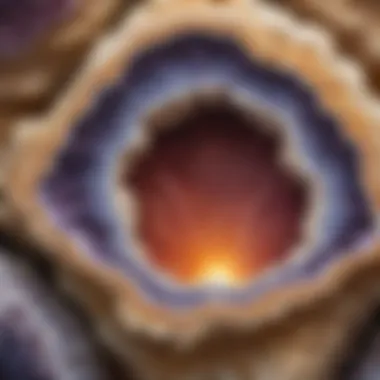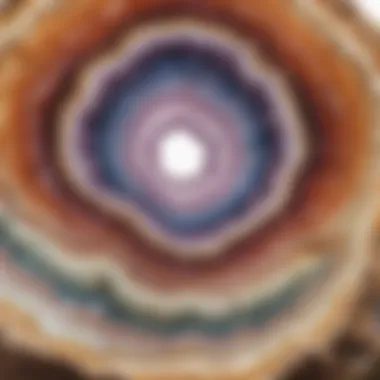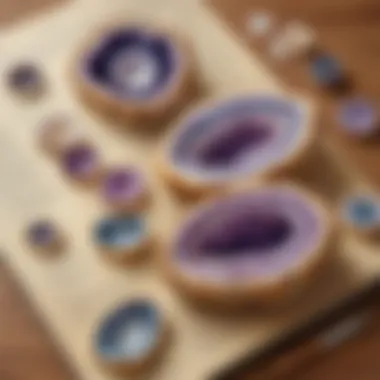Unveiling the Mystery: Identifying My Geode - A Geological Exploration


Science Fun Facts
Geodes, commonly known as nature's treasure chests, are spherical rocks with crystal formations inside. These mesmerizing geological wonders are formed in cavities within sedimentary and volcanic rocks. When magma or solutions seep into these spaces and slowly cool over time, crystals such as quartz, calcite, or amethyst begin to grow, creating the stunning beauty that geodes are known for.
Curious fact: Geodes can range in size from less than an inch to several feet in diameter. Their outer shell is often nondescript, hiding the sparkling surprise held within. It takes a keen eye and some geological knowledge to recognize a potential geode by its external appearance alone.
Discovery Journey Begins
Exploring the world of geodes opens up a realm of scientific wonders waiting to be uncovered. The journey of identifying a geode starts with understanding the geological processes that contribute to their formation. From sedimentary origins to igneous influences, each factor plays a role in shaping the unique characteristics of these natural marvels.
Geodes are like geological time capsules, preserving a snapshot of the conditions under which they formed. By studying the layers of crystals inside a geode, scientists can gain insights into the ancient environments and processes that shaped our planet millions of years ago.
Scientific Investigation
In the quest to identify a geode, scientific investigation reigns supreme. It involves scrutinizing not just the external features of a rock but also its weight, texture, and even conducting a simple tap test. Geodes tend to be hollow and lighter than ordinary rocks, owing to the crystal-filled cavity inside.
To unravel the mystery of a geode, one must pay attention to subtle clues like the shape of the rock, any visible crystalline structures peeking through cracks, and the overall symmetry of the specimen. Each detail provides valuable information that aids in confirming whether you've stumbled upon a geological gem.
Unlocking Nature's Marvels
As you delve deeper into the realm of geodes, a sense of wonder and appreciation for Earth's geological diversity unfolds. The process of identifying a geode transcends mere observation; it invites you to connect with the forces that have shaped our planet over millennia.
Peeling back the layers of a geode reveals more than just crystal formations; it unravels the story of geological processes at work beneath the surface. From tectonic movements to mineral crystallization, each intricate detail etched within a geode serves as a testament to the awe-inspiring forces that shape our world.
Introduction
Setting the Stage
Defining Geodes
In this section, we explore the fundamental concept of geodes, defining their unique nature within the realm of geology. Understanding what geodes are is crucial in unraveling their secrets and appreciating their allure. Geodes are geological formations that contain a cavity lined with crystals or other mineral matter, often resulting in stunning visual displays when opened. Their distinctiveness lies in their external ordinary appearance, contrasting sharply with the captivating beauty within. This section emphasizes the importance of recognizing the defining features of geodes to embark on a journey of discovery.
Mystery and Intrigue
Delving into the realm of mystery and intrigue surrounding geodes adds an exciting dimension to the exploration. Geodes evoke curiosity and wonder, offering a glimpse into the fascinating processes of nature that create these hidden gems. Their mysterious allure stems from the enigmatic way in which they form, locked away for centuries until discovered and opened. This section highlights the aura of mystery that surrounds geodes, inviting readers to appreciate the sense of fascination and curiosity they inspire.


Significance of Identification
The significance of correctly identifying geodes cannot be overstated, as it opens doors to a world of geological marvels. Accurately identifying geodes allows enthusiasts to appreciate their value, both aesthetically and scientifically. This section emphasizes the importance of honing observational skills and understanding geological indicators to identify geodes accurately. By recognizing the significance of identification, readers can immerse themselves in the exploration of these natural treasures, unlocking the secrets held within.
Geode
Geode 101 serves as the foundational knowledge base in the journey of uncovering the mystery behind geodes. This section delves deep into the intricate details surrounding geodes, exploring their formation processes, crystal structures, and the common minerals encased within. Understanding Geode 101 is crucial as it sets the stage for identifying these geological treasures accurately and appreciating their beauty to the fullest.
What Lies Within
Formation Process
The formation process of geodes is a crucial aspect to consider when deciphering these geological marvels. Through natural geological phenomena, geodes form in sedimentary and volcanic rocks, creating cavities that later become filled with mineral deposits. This unique process contributes significantly to the appeal of geodes, showcasing the wonders of nature encapsulated within seemingly ordinary rocks.
Crystal Structures
Crystal structures play a vital role in the allure of geodes, defining their internal beauty and intricate patterns. These structures form as mineral solutions seep into the cavities of geodes and crystallize over time, resulting in breathtaking formations that vary in complexity and color. Understanding crystal structures is essential for identifying and appreciating the intricate details hidden within geodes.
Common Minerals Encased
Exploring the common minerals encased within geodes provides insight into the diverse range of geological treasures waiting to be discovered. From quartz and amethyst to calcite and celestite, geodes often encase a plethora of stunning minerals that add to their uniqueness and charm. Recognizing these common minerals not only enhances the identification process but also deepens the appreciation for the geological diversity found within geodes.
External Features
Shape and Size
The shape and size of geodes offer valuable cues when determining their authenticity and potential beauty. Geodes come in various forms, from spherical to oblong shapes, with sizes ranging from small pebbles to massive boulders. Analyzing the shape and size of a geode can provide insight into its formation history and the mineralization processes that occurred, enriching the overall geode identification experience.
Color Variations
The color variations present in geodes offer a visual feast for enthusiasts keen on unraveling their mysteries. Geodes exhibit a spectrum of hues, from vibrant amethyst purples to subtle quartz whites, reflecting the minerals contained within. Understanding the significance of color variations aids in identifying different mineral compositions and appreciating the visual appeal each geode encapsulates.
Surface Texture
Assessing the surface texture of geodes reveals valuable information about their composition and environmental exposure. Whether smooth and glassy or rough and pitted, surface textures provide tactile clues to the formation conditions and mineral crystallization processes that have taken place. Analyzing surface textures is a foundational step in unlocking the secrets harbored within geodes.
The Art of Observation


In the quest to unveil the mystery behind identifying geodes, the art of observation plays a pivotal role. This section of the article emphasizes the crucial significance of keenly observing and analyzing various aspects of geodes. By honing in on specific details and characteristics, enthusiasts and curious minds can enhance their understanding and appreciation of these geological wonders. Observation in geode identification involves a meticulous examination of external features and internal structures, requiring patience and attention to detail to decipher the hidden beauty within.
Crack the Code
Light Test
The light test stands as a fundamental element in the process of identifying geodes. By subjecting a geode to light, enthusiasts can uncover essential information about its internal composition and crystal formations. This widely utilized method offers insights into the translucency, color variations, and possible mineral deposits within the geode. The key advantage of the light test lies in its simplicity and accessibility, making it an indispensable tool for both beginners and seasoned geode collectors. However, the light test may have limitations in certain cases where internal features are not easily discernible due to material opacity or external impurities.
Weight Analysis
Weight analysis forms another integral aspect of geode identification. Evaluating the weight of a geode provides clues about its density, potential mineral content, and overall size. This method assists in differentiating between hollow and solid geodes, guiding collectors in understanding the specimen's formation process. The significance of weight analysis lies in its ability to offer physical insights into the geode without requiring additional equipment. Despite its practicality, weight analysis may not always provide definitive answers, as variations in mineral densities and external factors can impact the accuracy of readings.
Sound Check
Engaging in a sound check serves as a valuable technique to further unravel the mysteries of geodes. By tapping or knocking on a geode, enthusiasts can listen to the resulting sound patterns, which can indicate the presence of air cavities, crystal formations, or solid mineral clusters. The distinctive sound produced during a sound check offers clues about the internal structure and composition of the geode. While the sound check provides auditory cues that supplement visual observations, it is essential to note that interpretations of sound may vary based on individual perception and the materials composing the geode.
Tools of the Trade
Magnifying Glass
Integrating a magnifying glass into the geode identification process enhances the observer's ability to scrutinize intricate details. The magnifying glass enables enthusiasts to closely examine the surface textures, mineral formations, and crystalline patterns within the geode. Its portability and magnification capabilities make it a preferred tool for conducting in-depth analyses of geode specimens. However, reliance on a magnifying glass alone may limit the observer's field of view and depth of analysis, necessitating complementary tools for comprehensive evaluation.
UV Light
The utilization of UV light introduces a unique perspective into geode identification by revealing fluorescent properties within the specimen. When exposed to UV light, certain minerals or crystals within the geode may exhibit fluorescence, aiding in mineral identification and distinguishing features that may be imperceptible under natural lighting. The application of UV light adds a layer of depth to the observation process, allowing collectors to unveil hidden aspects of the geode's composition that contribute to its overall allure. Despite its efficacy in illuminating fluorescent characteristics, UV light usage requires caution to prevent excessive exposure and potential damage to delicate specimens.
Geological Hammer
Incorporating a geological hammer into geode identification practices empowers enthusiasts to access the internal features of specimens through controlled breakage. The geological hammer facilitates the careful fracturing of geodes, allowing collectors to explore the crystal formations and cavity structures within. Its sharp edge and sturdy design enable precise strikes to split geodes without causing extensive damage, granting insight into the contents and quality of the specimen. While the geological hammer proves indispensable in revealing hidden treasures, users must exercise caution to prevent injury and preserve the external integrity of geodes during the extraction process.
Decoding the Geode
Decoding the Geode plays a pivotal role in the holistic exploration of geodes, providing valuable insights into their composition and structure. By delving into the inner workings of a geode, enthusiasts can unlock a treasure trove of geological wonders. Understanding the intricacies of Decoding the Geode is essential for enthusiasts seeking a deeper appreciation for these natural formations. This section will elucidate the significance of Decoding the Geode, shedding light on its fundamental elements and guiding readers towards a comprehensive understanding of these geological marvels.
The Reveal


Breakage Techniques
Breakage Techniques encompass a crucial aspect of geode exploration, offering a nuanced approach to unveiling the hidden beauty within. This method allows individuals to carefully extract the contents of a geode without causing damage to its internal structure. The precision involved in Breakage Techniques is paramount, ensuring that the crystals within remain intact and unscathed. While Breakage Techniques require skill and finesse, they are hailed for their ability to preserve the integrity of geode contents effectively.
Inner Chamber Exploration
Inner Chamber Exploration involves a meticulous process of delving into the heart of a geode to unveil its innermost secrets. By carefully maneuvering through the layers of crystal formations, explorers can discover the unique characteristics and patterns that define each geode. This method allows for a comprehensive analysis of the contents within, providing valuable insights into the geological history and composition of the specimen. Inner Chamber Exploration is revered for its ability to reveal the intricate beauty concealed within geodes, making it a vital component of the exploration process.
Crystal Identification
Crystal Identification forms the crux of geode exploration, enabling individuals to classify and categorize the crystals found within these natural wonders. By discerning the distinct features and properties of each crystal, enthusiasts can gain a deeper understanding of the geological forces at play. Crystal Identification aids in identifying rare specimens, determining their mineral composition, and appreciating the unique characteristics that make each geode truly one-of-a-kind. This segment will delve into the nuances of Crystal Identification, offering readers a comprehensive guide to distinguishing and discovering the treasures hidden within geodes.
Treasure or Not?
Value Assessment
Value Assessment serves as a vital component in the exploration of geodes, helping individuals understand the worth and significance of a particular specimen. By evaluating various factors such as rarity, crystal quality, and overall aesthetics, enthusiasts can determine the monetary and intrinsic value of a geode. Value Assessment allows collectors and enthusiasts to make informed decisions regarding the acquisition and preservation of geodes, ensuring that these geological wonders are appreciated and safeguarded for generations to come.
Collectible Criteria
Collectible Criteria outline the key attributes that elevate a geode to a collectible status, making it a prized addition to any collection. By examining factors such as size, crystal clarity, and external features, enthusiasts can identify geodes that exhibit exceptional beauty and unique characteristics. Collectible Criteria provide a framework for assessing the desirability and rarity of geodes, guiding collectors towards specimens that hold significant aesthetic and geological value. This section will delve into the nuances of Collectible Criteria, offering insights into what makes a geode a coveted collectible.
Display and Preservation
Display and Preservation are vital aspects of geode appreciation, ensuring that these natural treasures are showcased and safeguarded appropriately. By implementing proper display techniques and preservation methods, collectors can showcase the beauty of geodes while protecting them from environmental factors. Display and Preservation methods vary depending on the size and fragility of the geode, with options ranging from custom stands to climate-controlled storage. This segment will provide a comprehensive overview of Display and Preservation practices, guiding enthusiasts on how to exhibit and conserve their prized geode collections.
Conclusion
In concluding the meticulous journey of identifying your geode, the significance of the final stage cannot be overstated. The Conclusion segment serves as the crescendo, where the culmination of observations and assessments manifest into a tangible outcome of discovery and understanding. Through this article's guidance, readers are equipped with the necessary knowledge and techniques to navigate the intricate process of geode identification with confidence and precision. The Conclusion section not only reinforces the sense of accomplishment derived from successfully unraveling the enigmatic secrets of geodes but also underscores the invaluable learning experience gained throughout this enlightening exploration. Furthermore, Continued Fascination sparks the intrigue to delve deeper into the realm of geology, igniting a perpetual interest that transcends the bounds of the present inquiry.
Unveiling the Beauty
Sense of Accomplishment
Delving into the realm of geode identification, the Sense of Accomplishment is a fundamental aspect that resonates profoundly with enthusiasts and learners alike. This innate feeling of achievement stems from the meticulous process of decoding external clues and uncovering the concealed beauty within the geode. The Sense of Accomplishment embodies the rewarding sensation of successfully applying observation and analytical skills to solve nature's puzzle. Within this article, the Sense of Accomplishment serves as a beacon, guiding readers through the intricate path of geological exploration and enriching their experience with a profound sense of fulfillment.
Learning Experience
Amidst the quest of identifying geodes, the Learning Experience emerges as a cornerstone of personal growth and knowledge enrichment. Through hands-on engagement with geological specimens and the application of identification techniques, readers embark on a journey of discovery and education. The Learning Experience encapsulates the acquisition of new skills, the deepening of geological comprehension, and the cultivation of a curious mindset towards the natural world. Within this article, the Learning Experience serves as a pivotal element, empowering readers to expand their understanding of geology while fostering a sense of intellectual curiosity and exploration.
Continued Fascination
As the exploration of geodes unfolds, Continued Fascination emerges as a catalyst for enduring interest and engagement in the realm of geological mysteries. The allure of geodes transcends mere identification, captivating readers with their unique beauty and geological significance. Continued Fascination evokes a sense of wonder and intrigue that fuels a lasting passion for geological exploration. Within this article, Continued Fascination acts as a driving force, inspiring readers to delve deeper into the captivating world of geodes and fostering a sustained curiosity that paves the way for ongoing discovery and fascination.







